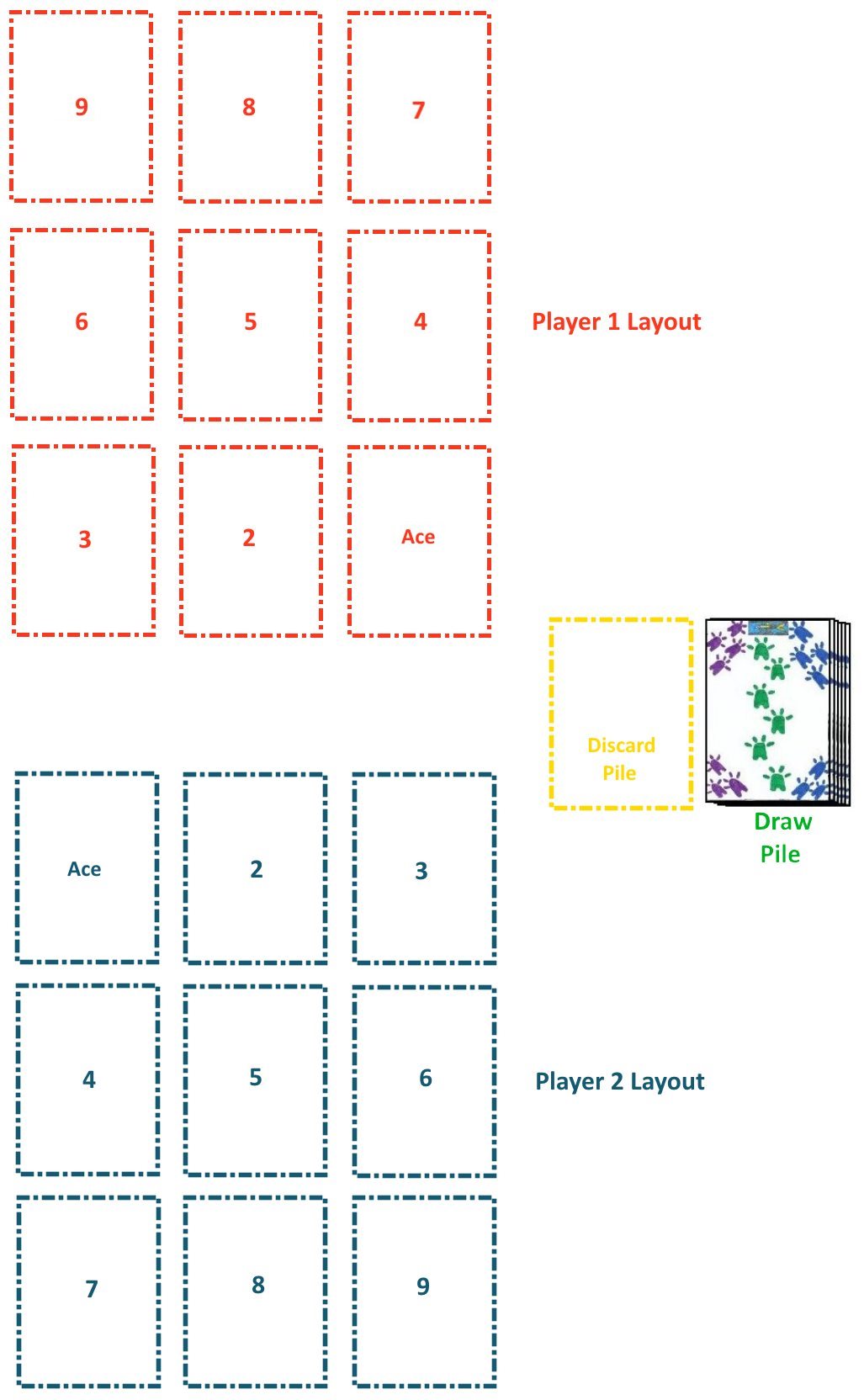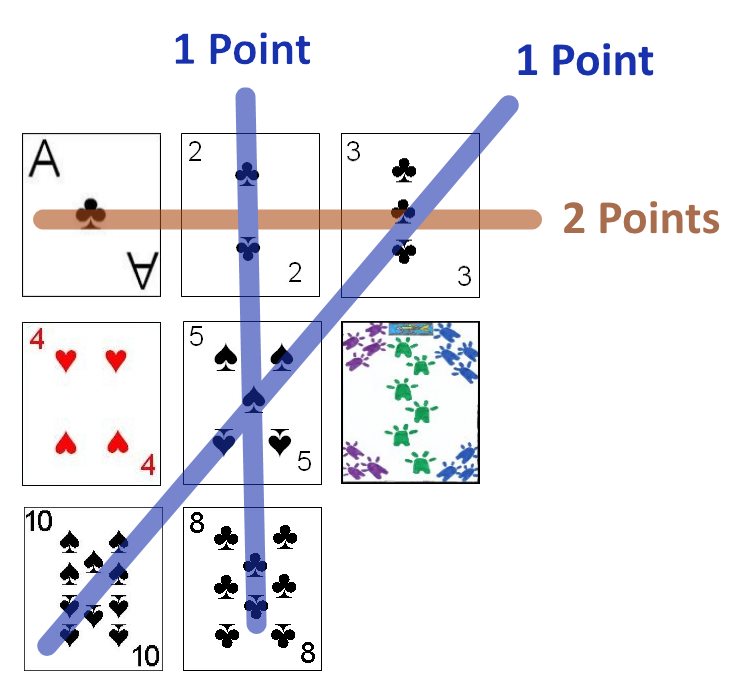How to Play the Card Game Leopard |
 Leopard is a card game invented by author and card game inventor Robert Abbot, first appearing in his 1963 book, Abbot's New Card Games. Leopard is a unique card game designed to be played by two players. The game uses two standard 52 card decks shuffled together. For best results, the decks should have identical back designs.
Leopard is a card game invented by author and card game inventor Robert Abbot, first appearing in his 1963 book, Abbot's New Card Games. Leopard is a unique card game designed to be played by two players. The game uses two standard 52 card decks shuffled together. For best results, the decks should have identical back designs.
Determination of the first dealer can be done using a number of methods, with draw for high card a common method (Aces are considered low for purposes of this draw). If both players draw a card of the same rank, they should each draw a new card. The players should seat themselves at the table in such a manner that they leave enough room for each player to have a three by three card square.
Once the first dealer has been determined, he should deal 8 cards face down to each player, starting with his opponent. He then places the remainder of the deck face down on the table as the stock pile. The dealer's opponent has the first turn, with the turns thereafter alternating amongst the two players.
 The object of the game is to attempt to maximize the scoring of your own layout while minimizing the score of
the layou of each of your opponents. To that end, players can play a card to his own or his opponent's layout during his turn. At the start of the game each player's layout will be completely empty but will be built and modified throughout the course of the game.
The object of the game is to attempt to maximize the scoring of your own layout while minimizing the score of
the layou of each of your opponents. To that end, players can play a card to his own or his opponent's layout during his turn. At the start of the game each player's layout will be completely empty but will be built and modified throughout the course of the game.
A player begins his turn by drawing the top card from the face-down stock. After the draw, he has a choice of several options:
- Discard: A player may elect to discard any card from his hand, which immediately ends his turn. This card should be added, face-up to a discard pile immediately next to the draw pile. The first player to discard will start the pile, and subsequent discards will be added to this pile.
- Play to your own square: A player may play a card from his hand onto his own square. Each player's square will ultimately end up as a 3 card by 3 card square, with 9 cards total (see sample diagram to the right). In addition to playing a card on an empty square to form the square, the player can also play a card directly on top of another card already on his square to improve the scoring capability of his score. There are several stipulations on the legal and allowable moves, listed further below.
- Play a card on your opponent's square : Similarly, a player can elect to play a card on his opponent's square. A card can be so placed on a blank spot on the opponent's square or alternately on top of another card already found comprising that square. As with playing to your own square, there are several stipulations on what cards can be played and where on the layout they can be played.
- Knock (Go Out): A player may knock on his turn, immediately ending the game (called Going Out). A player may only do this if his own square has a total scoring value of at least 5 points (see scoring section, below). Once a player knocks, the current total value of each player's square is calculated to determine the winner. In order to discourage knocking prematurely, however, a player who knocks receives a one point penalty to his final score at the end of the hand.
Once a player plays to the layout or discards a card to the discard pile his turn ends and the turn moves to his opponent.
As previously described, there are stipulations on what card can be played and where it can be played on one of the layouts. The following lists the legal allowable plays that can be made to the players or his opponent's layout:
- The Ace and the numbered cards (Ace, 2, 3, 4, 5, 6, 7, 8, 9) can be played into the corresponding location on the layout (see diagram). The Ace is equivalent to the value 1. Each location on the layout corresponds to the number 1 to 9 and a corresponding numbered card can be placed in its associated location on a player's layout. This play can be made to a player's own or his opponent's square. However, these numbered cards can only be played on the layout if that space on the layout is currently empty or the top card is face-down. In other words, this play cannot be made on top of an existing face-up card on the layout, even in the appropriate numbered location. This card is played face-up to the layout.
- A 10 can be played in any empty space on your own layout. A 10 may not be played on your opponent's layout. The 10 is played face-up to the layout.
- A Jack is played face-down to the layout, it can be played on your own or your opponent's square. Playing such a card essentially makes this an empty space again on the layout. Note that before playing the card face-down on the layout, the player should display the face of the card to his opponent.
- A Queen is similar to the Jack, also being placed face down, causing that space to be again be considered empty. However, a Queen may only be placed on a player's own layout (never on his opponent's).
- A King can be played only on your own layout and is placed face-up. A King can be played on any other card in the layout or on any empty space on the layout.
 The game continues in this manner, until one player knocks or the stock is exhausted and both players run out of cards. Once the stock has been exhausted and the last player plays his last card, the game also ends and the scores are calculated for each player's score to determine the winner. The following are the scores that can be earned:
The game continues in this manner, until one player knocks or the stock is exhausted and both players run out of cards. Once the stock has been exhausted and the last player plays his last card, the game also ends and the scores are calculated for each player's score to determine the winner. The following are the scores that can be earned:
- A line in a player's own square which contains three cards of the same suit earns two points.
- A line in a player's square (consisting of 3 cards) which are all of the same color (red or black), but not all of the same suit, earns one point.
- If no player has knocked, the hand ending with the stock exhausted, each point above 5 for which a player scores for in his square is doubled.
A line is considered a row of three cards adjacent to each other either horizontally, vertically or diagonally. Thus each player has a total of eight potential point scoring lines in his grid. A line that contains an empty space cannot be scored, since that line will contain fewer than 3 cards.
After the scores are calculated, the player with the highest total score is declared the winner.
 Revised Rules: After the original publication and release of this game,
Robert Abbot has suggested several changes to the game that enhance the
game. The following are the differences to the base game recommended by
Abbot:
Revised Rules: After the original publication and release of this game,
Robert Abbot has suggested several changes to the game that enhance the
game. The following are the differences to the base game recommended by
Abbot: